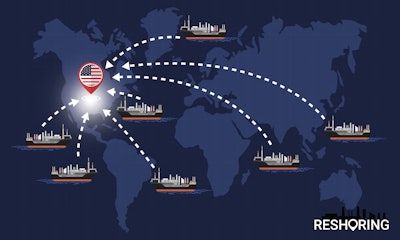
Many manufacturers are wondering if the bumpy road they’ve been on for the past few years has an offramp. On a good day manufacturing is a tough business.
U.S. reshoring and nearshoring activities are a microcosm of the state of international manufacturing, and that’s one reason why Kearney has been tracking this phenomenon through 12 editions of its annual Reshoring Index. This year’s report, based largely on results of activity throughout 2024, offers a reality check on whether the United States is up to the task of bringing manufacturing back in a meaningful way.
The State of Reshoring
After two consecutive years of momentum, Kearney’s 2025 Reshoring Index saw its first significant drop, raising fundamental questions about the sustainability of the upward trajectory of U.S. manufacturing. Despite substantial investments in domestic production capacity, manufacturing gross output (MGO) has been virtually flat since early 2023 after most of the latent capacity was absorbed.
Mexico, previously the major post-COVID beneficiary of the shift from faraway manufacturing locations to nearby alternatives, remains a reliable partner in categories such as automotive and electrical equipment, where the country has established manufacturing expertise. But expanding beyond these core sectors sees Mexico face infrastructure issues and other challenges.
A Flip, But Not Unexpected
Take an in-depth look at the data from the 2025 Reshoring Index, and a clear picture emerges. The post-pandemic urge to shorten supply chains fueled back-to-back years of significant growth in manufacturing gross output (MGO). But once most of the latent U.S. manufacturing capacity was absorbed, the revamped ecosystems struggled to scale quickly enough to keep up with the growth of domestic demand because it took more time than expected to convert capital into capacity. So, the MGO slowdown was not entirely surprising.
Where Mexico was able to fill the gap between demand and supply in 2022 and 2023 by offering companies a nearby alternative to Asian low-cost countries and regions (LCCRs), its manufacturing output growth also started to slow down in 2024, forcing companies to turn back to Asian LCCR sources.
And with an almost-flat MGO and a return to growth for imports from Asian LCCR, the Reshoring Index flipped.
Over the past two years, MGO growth slowed to around one percent year over year, a significant drop from the roughly 30 percent gain between 2020 and 2022 when latent capacity could be activated relatively quickly. Key investments in advanced manufacturing faced delays as manufacturers grappled with regulatory requirements, skilled labor shortages and demand uncertainties.
Meanwhile, on the demand side, the U.S. personal goods consumption expenditure initially grew at a slower pace than MGO coming out of the COVID-19 pandemic (about 25 percent between 2020 and 2022) and has now also slowed after several years of surging inflation. But it is still growing at two percent, or twice the MGO growth rate, adding roughly $150 billion to U.S. demand.
Slowing Demand Growth Gives Pause
In an environment where demand growth started slowing down and inflation continues to drive up interest rates, it’s no surprise that, even in cases where capacity was made available, manufacturers paused before they turned on that capacity and staffed up more aggressively.
Several major semiconductor players, for instance, have postponed starting up production at new U.S. facilities, citing complex approvals and higher-than-expected operational costs. Others have slowed or paused equipment orders following a drop in chip sales and a buildup of excess inventory.
After a scorching surge since the pandemic, Mexico also remained the United States’ top trade partner for manufactured goods last year, reflecting our southern neighbor’s continued strength in core manufacturing categories. Mexico accounted for 16 percent of total imports, or $457 billion, with most of its export gains of $33 billion versus the previous year coming from three sectors: computer and electronic products, transportation equipment, and electrical equipment, appliances, and components. But that amount of additional imports only partially closed the gap between demand and supply.
No surprise, then, that Asian LCCRs, including China, saw their 2024 imports into the U.S. climb from $0.878 trillion to $0.968 trillion—a $90 billion increase—with around 65 percent of that import uptick coming from three sectors: computer and electronics (+$31 billion), electrical equipment (+$18 billion), and chemicals (+$10 billion).
Less Self-Sufficient
As a result of having to resort to more imports, the United States also reversed another trend: between 2021 and 2023, the country had started to become more self-sufficient, as was evident in the increase of the Kearney Self-Sufficiency Index (SSI), which looks at the ratio between how much is made in the United States for the domestic market and how much is net imported.
In the latest tally, imports rose by about $155 billion (six percent), while net made-for-market increased by only about $26 billion (less than one percent). This imbalance eroded the SSI and reversed the upward trend seen over the preceding two years.
It’s important to note that most of the dynamics that drove this reversal in both the Reshoring Index and the SSI were in motion long before the outcome of the November 2024 U.S. election was known. This suggests that this dynamic is rooted more in structural lags and market-driven realities than in politics and policy changes.
And despite recent trade policy upheavals, it’s those same market realities and structural dynamics that are most likely to determine the direction reshoring will take, and whether the greater alignment among investment, capacities, capabilities, and market demand that’s needed for reshoring to return to the momentum seen in prior years will indeed occur.
It’s Not All Bad News
Despite last year’s trade data showing a negative trend around reshoring, looking forward, our CEO survey conducted in March found a 15 percent increase in leaders who are planning to reshore part of their operations, citing geopolitical tensions as a key motivator.
But for the third year in a row, CEOs also identified labor cost as the top challenge to reshoring and nearshoring, with nearly 25 percent ranking it as their primary barrier. With wages in Asian LCCRs still dramatically lower than in the United States, reshoring faces an uphill battle unless it’s supported by productivity gains or structural cost reductions.
Labor shortages and skills gaps are compounding the cost issue, as finding qualified talent is becoming more difficult, especially in sectors such as primary metals, where retirements outpace new entrants. Addressing this will require a coordinated push for workforce development, including customized training programs, industry–government partnerships, and a rebranding of manufacturing as a safe, clean, future-forward, high-tech sector that appeals to Gen Z’s desire for stability, flexibility, and relevance in the age of AI.
To that point, more than 65 percent of the manufacturing executives that Kearney surveyed believe AI will drive those necessary improvements in quality control, efficiency, and supply chain management within the next three to five years.
All that being said, companies aren’t walking away from reshoring. they’re just pausing to reassess. Investments are continuing, but with greater caution. The next phase of reshoring will be defined by hard choices about what to produce, where to invest, and how to compete in a fragmented, fast-moving world, knowing that manufacturing ecosystems scale best when market signals are strong and clear, capabilities are in place, and supply chains can flex and adapt with speed and confidence.
Shay Luo is a partner in the Strategic Operations practice of Kearney, a global management consulting firm.





















